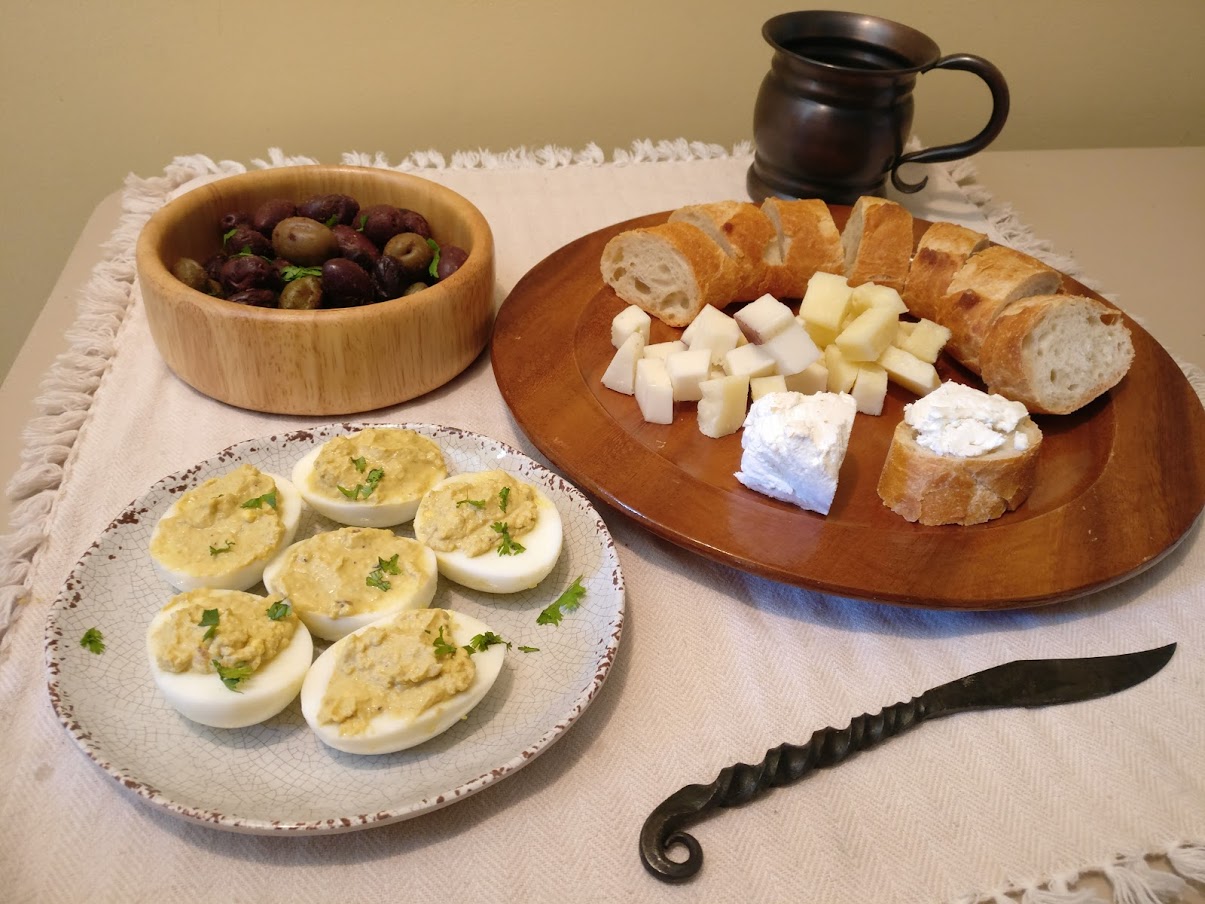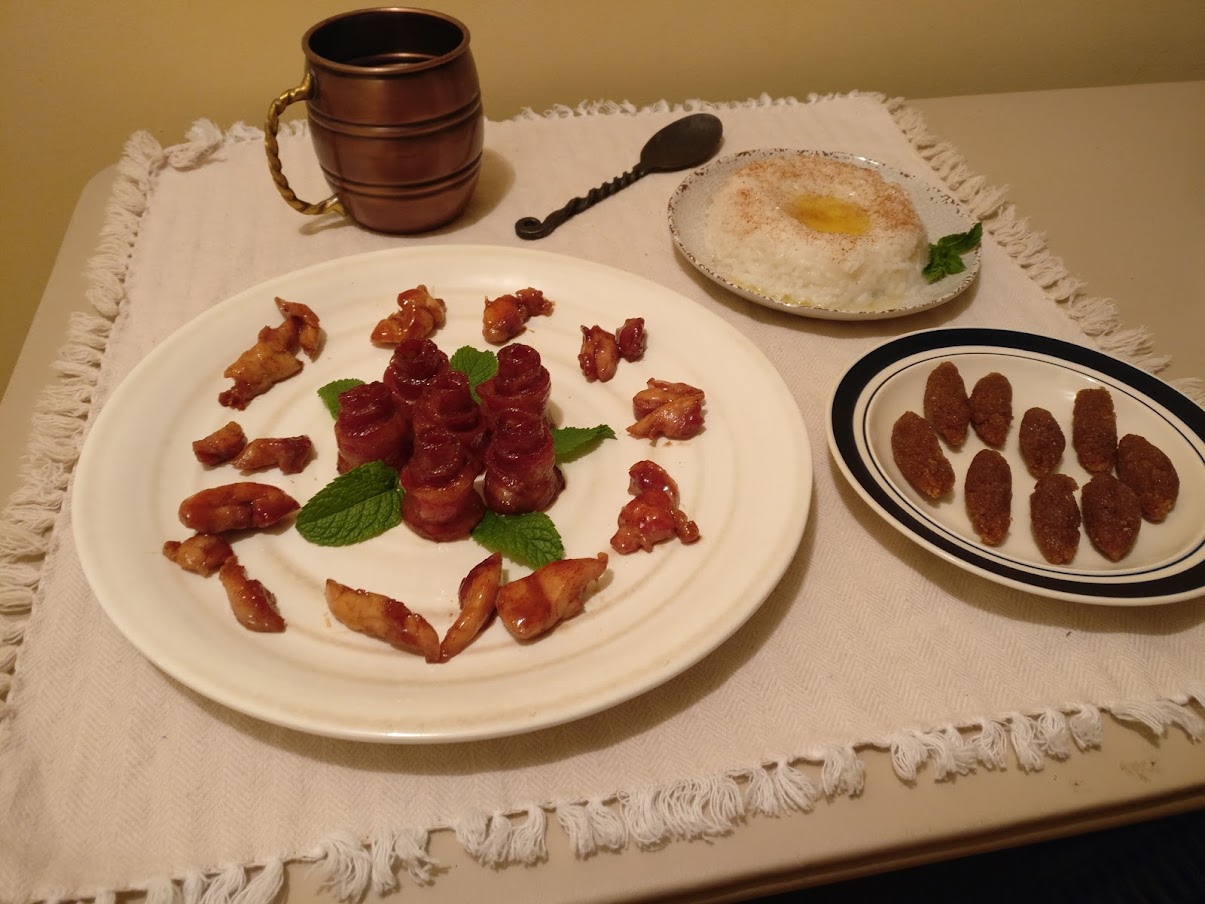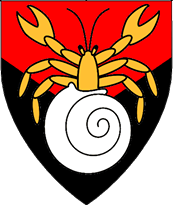Atlanian Spring Coronation 2020 (Cancelled due to plague)
By Heinrich von Holstein
This feast was meant to be presented at the Atlantian Spring Coronation in 2020. However, this event was cancelled due to COVID19’s spread at the time. Later that summer I cooked all four courses with smaller portions and posted these images and descriptions online. I hope some day I can implement the entire feast at scale for my Kingdom’s populace.
Menu
First Course:
- Bread
- Assorted Cheeses
- Smoked Olives
- The Making of Stuffed Eggs (Anonymous Andalusian)
Second Course:
- Roast Pork
- Allos quesos “Garlic Cheese” (Sent Sovi)
- Salsa de bolets “Mushrooms sauce” (Sent Sovi)
- Llentilles “Lentils” (Sent Sovi)
- Porrada “Leek Puree” (Sent Sovi)
Third Course:
- Roast Chicken
- Llimonea “Lemon Sauce” (Sent Sovi)
- Cirons tendres “Tender Chickpeas” (Sent Sovi)
- Pastanagat “Carrot Puree” (Sent Sovi)
- Esparrecs “Asparagus” (Sent Sovi)
Fourth Course:
- Recipe for Honeyed Rice (Anonymous Andalusian)
- Preparation of Juraydât, “Small Locusts” (Anonymous Andalusian)
- Recipe for Jullâbiyya, a Dish with Julep (Anonymous Andalusian) – Candied Chicken and Bacon Roses
Description

The first course starts with crusty bread and assorted goat and sheep’s milk cheeses. In this case I had Manchego, a classic and period Spanish sheep cheese, Murcian Wine Cheese (goat), and fresh goat cheese to spread on the bread.
The smoked olives are dusted with a little bit of cumin. Being served warm makes them soft and the pits are easier to manage..
Lastly, we have The Making of Stuffed Eggs from the Anonymous Andalusian Cookbook. They are a flavor triad of sweetness from onion juice, saltiness from soy sauce (a substitute for a medieval Arabic condiment called “murri”), and spiciness from ground pepper, coriander, and fresh cilantro.

The second course features roast pork, tenderloin for this miniature feast, rubbed with salt, sage, and long pepper, a relative of black pepper which has some floral, herbal notes to its flavor.
Allos quesos, “Garlic Cheese”, is a sauce meant to go with the pork. It is cheese (Manchego) blended with fresh garlic and thinned with water and oil until it has a sauce consistency. It is creamy yet with a very bold garlic flavor.
The recipe for Salsa de bolets, “Mushroom Sauce”, describes an alternate preparation that can stand on its own. The mushrooms are fried and served with onions, parsley, and vinegar. This makes an excellent alternative topping for the pork should anyone feel the garlic cheese is too potent.
Llentilles, “Lentils”, are a wonderful companion to this hearty course. They are boiled tender, thickened with breadcrumbs, then mixed with minced onions and garlic fried golden brown. The dish is given some brightness from vinegar and fresh herbs of parsley, sage, and mint.
The Porrada, “Leek Puree”, certainly has a striking color and a flavor to match. It is cooked in oil, made smooth with almond milk and sugar. It is sweet and creamy but distinctly sharp from being an onion-like vegetable.

Our third course has chicken with salt, black pepper, and just a little bit of garlic. For this feast the chicken was pan-fried, but for the full menu I would have it grilled.
Llimonea, “Lemon Sauce”, is meant to accompany the chicken. This is a very flavorful sweet and sour sauce of sugar, lemon juice, ginger, saffron, and almond milk. The ingredients are all reduced down to a thin glaze with a rich golden color.
This preparation of Esparrecs, “Asparagus”, has them boiled, fried, splashed with wine and sprinkled with cinnamon and sugar. The flavor of the vegetable is still present but plays well with the sweet treatment often used in medieval dishes.
Cirons tendres, “Tender Chickpeas”, are so named for being boiled tender in a broth of almond milk and onions. The dish is soft and hearty but brightened and sweetened considerably by a late addition of oil, sweetened vinegar (a substitute for the hard-to-find verjuice specified in the recipe), more onions but chopped fresh ones, ginger, and herbs of parsley and basil.
Rounding out this course is a creamy and mildly sweet Pastaganat, “Carrot Puree”. The carrots are boiled soft, mashed, and made smooth by mixing in almond milk. The dish is topped with shredded Manchego cheese.

For dessert, the menu swings back towards the Anonymous Andalusian and we have a Recipe for Preparing Honeyed Rice. The sweetened rice is cooked very soft but still solid enough to be formed. An indentation is made in the center so it can be served with a pool of melted butter. Finally, it is dusted with cinnamon and sugar.
Next we have Preparation of Juraydât, Small Locusts. Fear not, however, for they are not insects but rather small candies similar to Medieval “gyngerbrede”. Honey is boiled briefly and mixed with breadcrumbs that have been soaked in oil and spices. For this preparation, I reviewed other desserts in the same cookbook and chose long pepper, cinnamon, and saffron. The recipe describes rolling them like a hazelnut or a meatball, but I decided to make these oblong and maybe looking more locust-like. Appearance aside, they are soft and chewy, sweet and spicy.
Finally, a dish inspired by Recipe for Jullâbiyya, a Dish with Julep (Anonymous Andalusian), Candied Chicken and Bacon Roses. These sweet and salty treats smell like actual roses! They are coated in a caramelized sauce of sugar, cinnamon, cloves, ginger, and rosewater. The original recipe describes candying an entire, whole chicken, but I felt that might be a bit impractical for dessert so I used smaller, bite-sized pieces.
Sources
Suñol, Joan Santanach I, editor. The Book of Sent Soví: Medieval Recipes from Catalonia. Translated by Robin M. Vogelzang, Barcino Tamesis, 2008.
